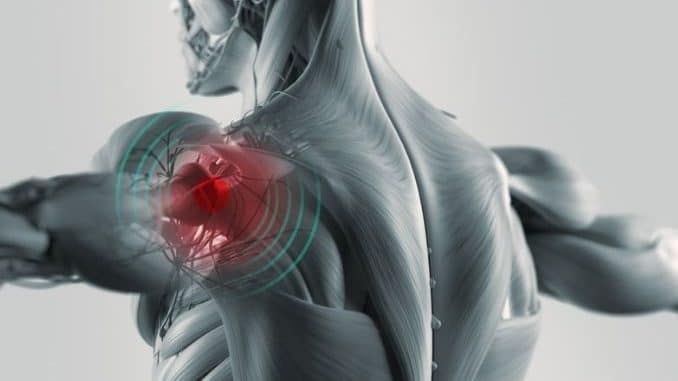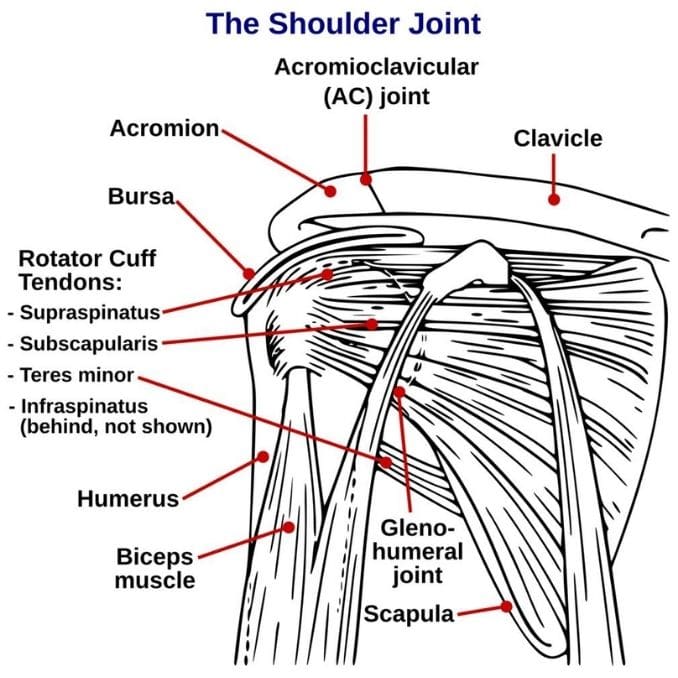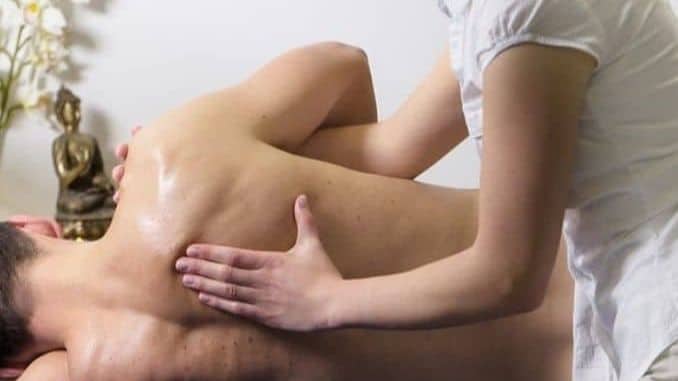
We received the following question from one of our readers:
I’ve discovered my shoulder pain for so long has emanated from a type of subluxation of the bicep tendon being out of its bicep groove on the humorous as it enters the joint capsule and maybe even beyond. So, now I’m completely confused. It wasn’t a doctor who told me this. It was an osteopath ― a highly regarded osteopath. He asked me to keep coming as it will take some work to fix but is this reasonable and realistic? Are there stretches and exercises to speed up and optimize my results?
Let’s look at the biceps and shoulders more closely, so we can see what’s happening here.
What Are the Bicep Muscles?
The bicep muscles are the ones that show up when you flex your arm, and the ones we sometimes refer to as “the guns.” Each muscle is positioned on the front of the upper arm between the shoulder and the elbow, and its main purpose is to flex the elbow and rotate the forearm. It also helps support other muscles when lifting or lowering the forearm.
The bicep muscle is attached to the shoulder at two places — that’s why it’s called “bi,” meaning “two.” Throughout the body, we have tendons that attach our muscles to the bones and, in the case of the biceps, there are two that hold the muscles to the shoulder. The bicep muscle itself is made up of two parts, and it’s from these two parts that the two tendons emerge.
Imagine two rivers flowing separately and then coming together to form one river. That will give you a visual of what the bicep muscle looks like. The point of origin — called the “head” in a muscle — is also the point where the tendon attaches the muscle to the bone.
So, imagine the bicep muscle as two rivers coming from the shoulder blade and then coming together into one river at the “belly” of the muscle or what we may think of as the bulge. Then the one river moves on down to attach via one tendon to the radius, a bone in the forearm.
When speaking of the two “heads” of the muscle, which are where the tendons attach to the bone, we call them by two names:
- Long head: This part of the muscle originates at the top of the shoulder socket.
- Short head: This part of the muscle originates from the coracoid process, which is a small hook-like structure on the back part of the scapula (shoulder blade).
These may be referred to as tendons or muscle heads.
What Is a Biceps Tendon Subluxation?
Relieve Shoulder Pain Caused by a Bicep Tendon: Bicep injuries can occur in either of the two tendons attaching the biceps muscle to the shoulder blade. It’s more common, however, for the long head to be the culprit in any type of shoulder pain, as described in the question above.
The short head is farther away from the shoulder joint and has a more solid attachment to the bone. The long head runs through a groove at the front of the shoulder, then through the rotator cuff before attaching to the shoulder socket. A rotator cuff is a group of muscles and tendons that wrap around the front, back and top of the shoulder joint to hold the upper arm bone securely in the socket of the shoulder joint.
A “subluxation” occurs when the tendon partially or completely dislocates from the bone or joint. In the case of a bicep tendon subluxation, something happens that allows the tendon to dislocate partially out of the groove where it normally sits. This type of injury often accompanies problems with the rotator cuff as well. A rotator cuff tear, for instance, can cause a biceps tendon subluxation too.
Symptoms of a biceps tendon subluxation include:
- Pain over the front of the shoulder
- Pain with internal rotation
- Swelling in the shoulder area
- Pain radiating down to the biceps muscle
- Snapping or clicking sensation in the shoulder
- Rotator cuff problems
What Causes Biceps Tendon Subluxation?
Relieve Shoulder Pain Caused by a Bicep Tendon: Most commonly, some sort of shoulder injury causes the biceps long head tendon to partially or fully dislocate. The most common injury is a rotator cuff tear, which damages the nearby tendons, including the long head tendon.
Sometimes, the long head tendon does not fully slip out of the groove, but the weakness of the external rotators causes the tendon to push against an injured or ruptured transverse ligament, which is painful.
An injury or other issues can also cause the long head tendon to become inflamed, which again leads to swelling and pain. The tendon may not be dislocated but inflamed and damaged.
Rotator cuff tears, which can lead to biceps tendon subluxation, can be caused by:
- An acute injury, such as a fall
- An athletic injury, such as what may occur in baseball pitchers, archers and tennis players
- A repetitive injury, such as repeated overhead activity or heavy lifting over a long period of time
- Progressive wear and tear on the tendon tissue that can occur with age
- Other potential causes of a biceps tendon inflammation or dislocation include:
- Gradual degeneration of the tendon from athletics or occupations requiring repeated overhead motion
- Normal aging wear and tear
How Is Biceps Tendon Subluxation Treated?
Relieve Shoulder Pain Caused by a Bicep Tendon: Treatment depends on the severity of the damage. If the tendon is only inflamed or partially dislocated and the surrounding tissues, tendons, ligaments and joints are OK, the following treatments should help ease pain and encourage healing:
- Rest
- Ice as needed to relieve pain and inflammation
- Anti-inflammatory medications like ibuprofen or aspirin
Once the tendon starts to heal, it’s important to focus on stretching and strengthening exercises to bring the shoulder back to full health. We include some of those for you below.
Relieve Shoulder Pain Caused by a Bicep Tendon: If these treatments don’t work well enough, your doctor may recommend injections to help relieve the pain along with continued physical therapy. Surgery is used only as a last resort, and only after other treatments have not proven effective. The most common technique is called “tenodesis,” and involves securing the long head tendon into the groove where it’s supposed to lay using screws or sutures.
If the injury is accompanied by a rotator cuff tear, the same types of treatments are usually recommended unless the tear is severe. Then surgery may be required.
Exercises and Stretches to Help Heal a Biceps Tendon Subluxation
CLICK HERE to watch the YouTube video.
Always check with your doctor before trying these exercises. A reliable diagnosis is best.
For internal rotation, external rotation and abduction, try the following.
1. Isometric Internal Rotation
Face an outside corner of a wall or a door frame. The shoulder you are exercising should be near the door opening or corner of the wall.
Bend your elbow 90 degrees, make a fist and press into the corner wall or door jamb gently as if you were trying to rotate your hand inward toward your belly button. Remember, no motion should occur in your shoulder during the exercise. Use a small folded towel for padding if needed. Press and hold for 5 seconds and then release slowly. Repeat 10 to 15 repetitions.
2. Isometric External Rotation
This can help strengthen your rotator cuff muscles, specifically your teres minor and your infraspinatus. Continue standing perpendicular to a wall about 6 inches from it. The shoulder you are exercising shoulder be closest to the wall.
Bend your elbow 90 degrees, make a fist and press the back of your hand into the wall as if you were rotating your arm outward. Use a small towel for padding if needed. Press into the wall gently for about 5 seconds. Release pressure on the wall slowly. Repeat the exercise 10 to 15 repetitions.
3. Isometric Shoulder Abduction
Stand about 6 inches from a wall but turn your body so that it is perpendicular to the wall. The shoulder you wish to exercise should be close to the wall.
Make a fist and press it into the wall. You may wish to use a folded-up towel for extra comfort. Press into the wall gently as if you are trying to lift your arm out to the side and hold it there for 5 seconds. Release pressure on the wall slowly. Repeat the exercise 10 to 15 repetitions.
Internal and External Rotation in Neutral With TheraBand Resistance
1. TheraBand Shoulder External Rotation at 0 degrees
Begin with one end of the band securely attached waist-high. You may place a towel roll under your arm as well. Grasp the other end of the band with tension. Pull the band away from the wall, rotating your forearm outward. Hold and slowly return.
Tip: Be sure to keep your forearm parallel to the ground, your elbow by your side and your wrist straight.
2. TheraBand Shoulder External Rotation at 90 degrees
Begin with one end of the band securely attached in front of your shoulder high. Grasp the other end of the band with tension. Pull the band away from the wall, rotating your forearm backward. Be sure to keep your upper arms parallel to the ground, your elbow at shoulder level and your wrist straight.
Tip: Don’t let your elbow drop below shoulder level. Keep elbow bent at 90 degrees, and don’t extend your elbow to complete the motion.
3. TheraBand Shoulder Internal Rotation at 0 degrees
Begin with one end of the band securely attached waist-high. You may place a towel roll under your arm as well. Grasp the other end of the band with tension. Pull the band away from the wall, rotating your forearm inward. Hold and return slowly.
Tip: Be sure to keep your forearm parallel to the ground, your elbow by your side and your wrist straight.
4. TheraBand Shoulder Internal Rotation at 90 degrees
Begin with one end of the band securely attached behind you shoulder-high. Grasp the other end of the band with tension. Pull the band away from the wall, rotating your forearm inward. Be sure to keep your upper arms parallel to the ground, your elbow at shoulder level and your wrist straight.
Tip: Don’t let your elbow drop below shoulder level. Keep elbow bent at 90 degrees, and don’t extend your elbow to complete the motion.
5. TheraBand Shoulder Abduction to 180 degrees
Begin with the end of the band or tubing stabilized under your foot. Grasp the end in your hand with slight tension on the band or tubing and lift your arm outward. Keep your elbow straight and your thumb up. Hold and return slowly.
Do not perform this if it causes shoulder pain. Keep your back straight and avoid leaning over or shrugging your shoulder.
For your guide to eliminating shoulder pain, check out Shoulder Pain Solved, here!





